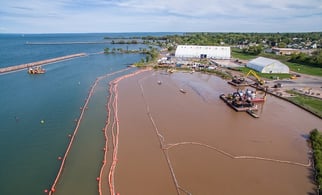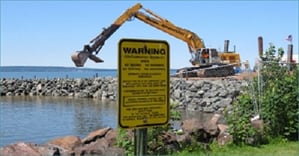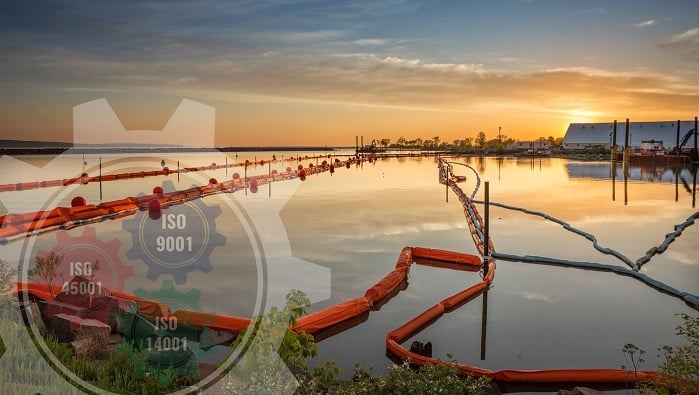As a marine solutions company, J.F. Brennan Company, Inc. (Brennan) faces a unique array of regulations and rules. While every company deals with regulations, most deal with rules that impact operations only on land or only in the water. We are accountable for regulatory requirements in both areas and have been for years. So, what's changed and what are we doing about it?
What are the major changes in environmental compliance?
In recent years, we have seen two significant changes within environmental compliance regulations, both outside and within our industry.
-
Federal, state, and local governments track business activities much more closely.
This translates to an increase in potential trouble for companies that aren’t following the rules precisely.
-
Our clients are increasingly focused on the activities we perform for them during project work.
This is a fundamental change from the past, when it was a luxury to find a contractor who followed environmental regulations. Now, environmental regulation management is an absolute requirement—one that clients monitor aggressively. On some client sites, a single drop of oil impacting the ground means an “all-stop” to work until cleanup and reporting are completed. Serious business, indeed.
What is Brennan doing to ensure environmental compliance?
 Brennan has always been sensitive to the environment and we follow the rules. Our business reputation is built on doing the right thing, as well as doing it better than any of our competitors. When we most recently reviewed these regulatory and client changes, we realized we need more dedicated resources across the company to ensure that we meet or exceed government and client requirements.
Brennan has always been sensitive to the environment and we follow the rules. Our business reputation is built on doing the right thing, as well as doing it better than any of our competitors. When we most recently reviewed these regulatory and client changes, we realized we need more dedicated resources across the company to ensure that we meet or exceed government and client requirements.
During the planning for the company-wide Brennan Quality Management System it was apparent that a key component would involve managing all our environmental responsibilities whether they arose from regulatory obligations, client requirements or Brennan best practices.
Implementing A Responsible Environmental Management System
 Brennan's Quality Management System incorporates three internationally recognized standards, ISO-9001 (Quality), ISO-14001 (Environmental Management) and ISO-45001 (Safety program management).* Our ability to meet environmental responsibilities is now underpinned by the strength of an integrated system which looks at all relevant factors that may impact the business and provides impressive tools for performance management and continual improvement.
Brennan's Quality Management System incorporates three internationally recognized standards, ISO-9001 (Quality), ISO-14001 (Environmental Management) and ISO-45001 (Safety program management).* Our ability to meet environmental responsibilities is now underpinned by the strength of an integrated system which looks at all relevant factors that may impact the business and provides impressive tools for performance management and continual improvement.
*Brennan chose British Standards Institution (BSI) as our registrar. BSI is one of the three main registrars in the world for ISO certification.
Elements we prioritize in our environmental management system:
There are three elements in our quality management process that we prioritize to ensure an educated, environmentally responsible organization.
1. Our Environmental Risk and Impact Assessment
This process, also known as an aspect and impacts study, is where we examine all the ways that we could possibly impact the environment across our locations, as well as consider potential effects or risks. We then put processes or plans in place to prevent risky actions from occurring and establish proper emergency responses.

2. Knowledge of the System
Every employee understands that we have a documented system and observation program for dealing with environmental risks, and that the system contains resources to establish requirements for our activities and response plans.
3. Reasonable Care
Reasonable care applies to activities across the company at every level. Reasonable care is “the degree of caution and concern an ordinarily prudent and rational person would use in similar circumstances.” Using reasonable care as we go about our tasks drives a common-sense—and highly effective—approach to dealing with risks. It means that we plan activities before we start, taking risks into account, and then perform those activities based on established rules and requirements. After completing operations, we review to ensure our effectiveness and drive process improvement.
It's Our Corporate Responsibility
This year, Brennan made great strides regarding environmental management and our level of compliance. Throughout the year, we used external audits, internal inspections, and employee training to help us correct issues—some that we weren’t even aware existed. It has been an excellent opportunity for all of us at Brennan to learn, working together to ensure that our daily tasks don’t pose a risk to the environment.
Effective control and management of our environmental responsibilities keeps regulators and clients satisfied. And, it’s the right thing to do—that’s the hallmark of Brennan.
Video highlights of our environmental cleanup work on the manufactured gas plant (MGP) site in Ashland, WI.
For additional information relating to this topic, check out our AWO-RCP, Subchapter M, and ISO Certification and Safety blogs, or drop us a note below.


